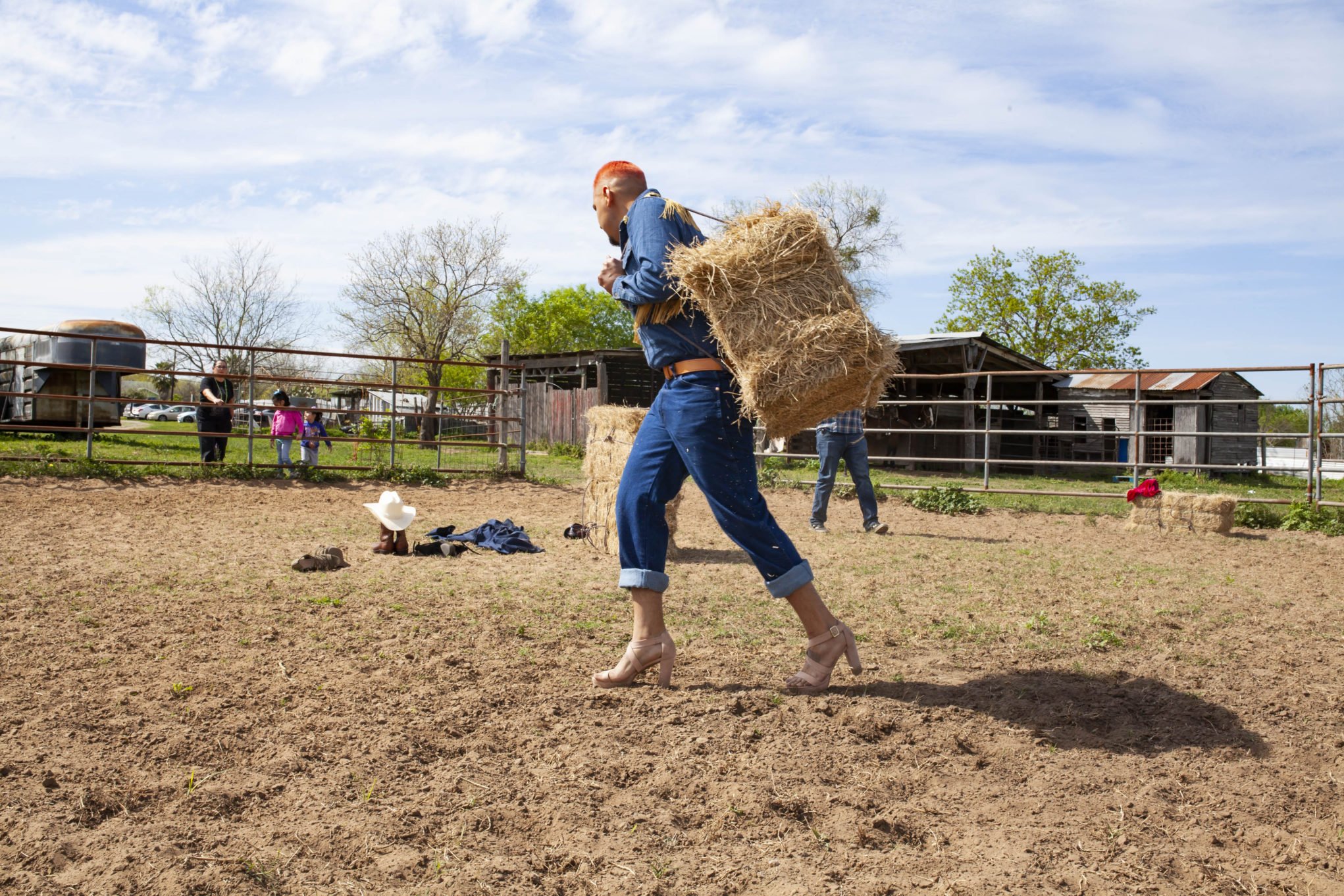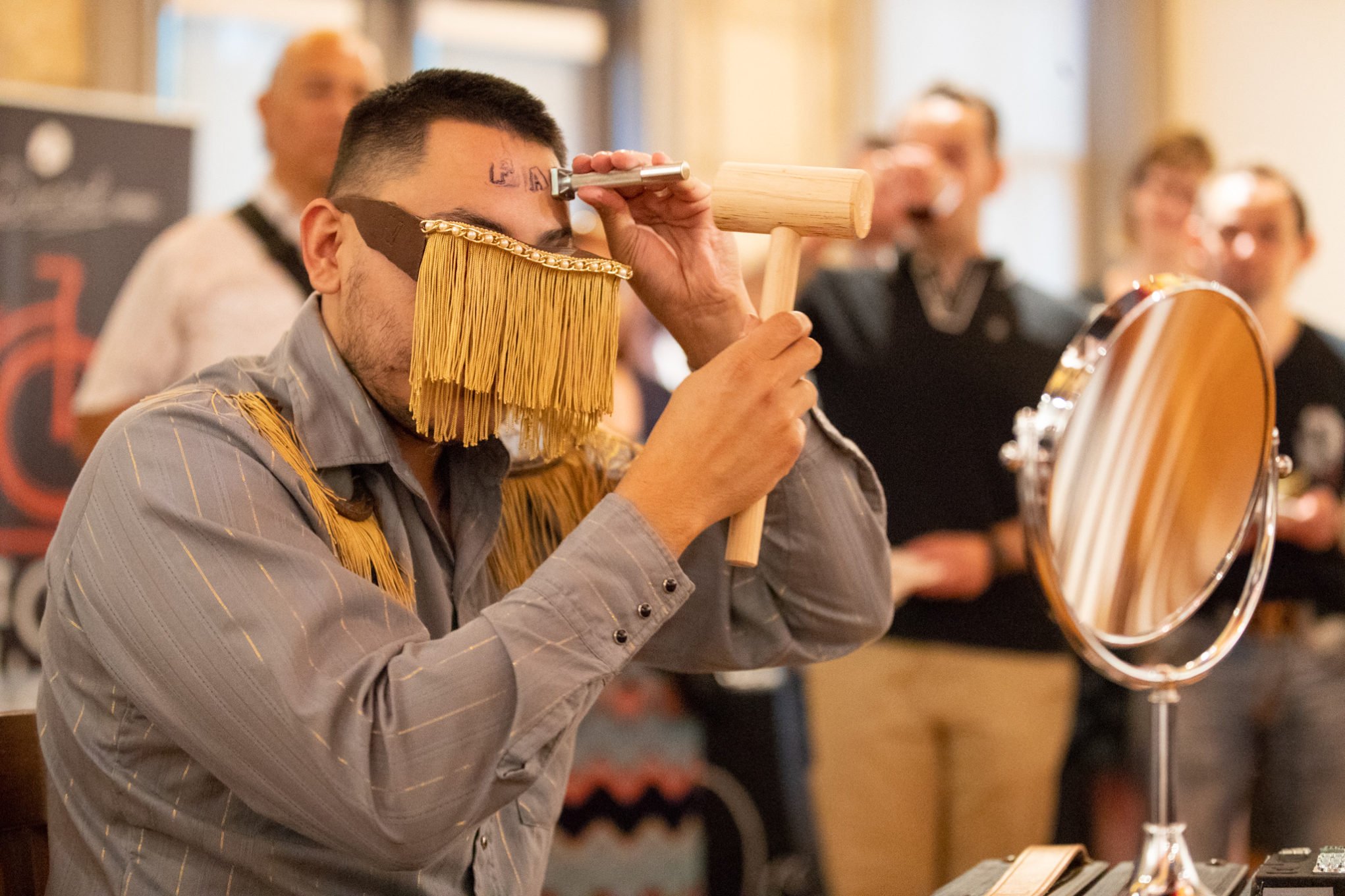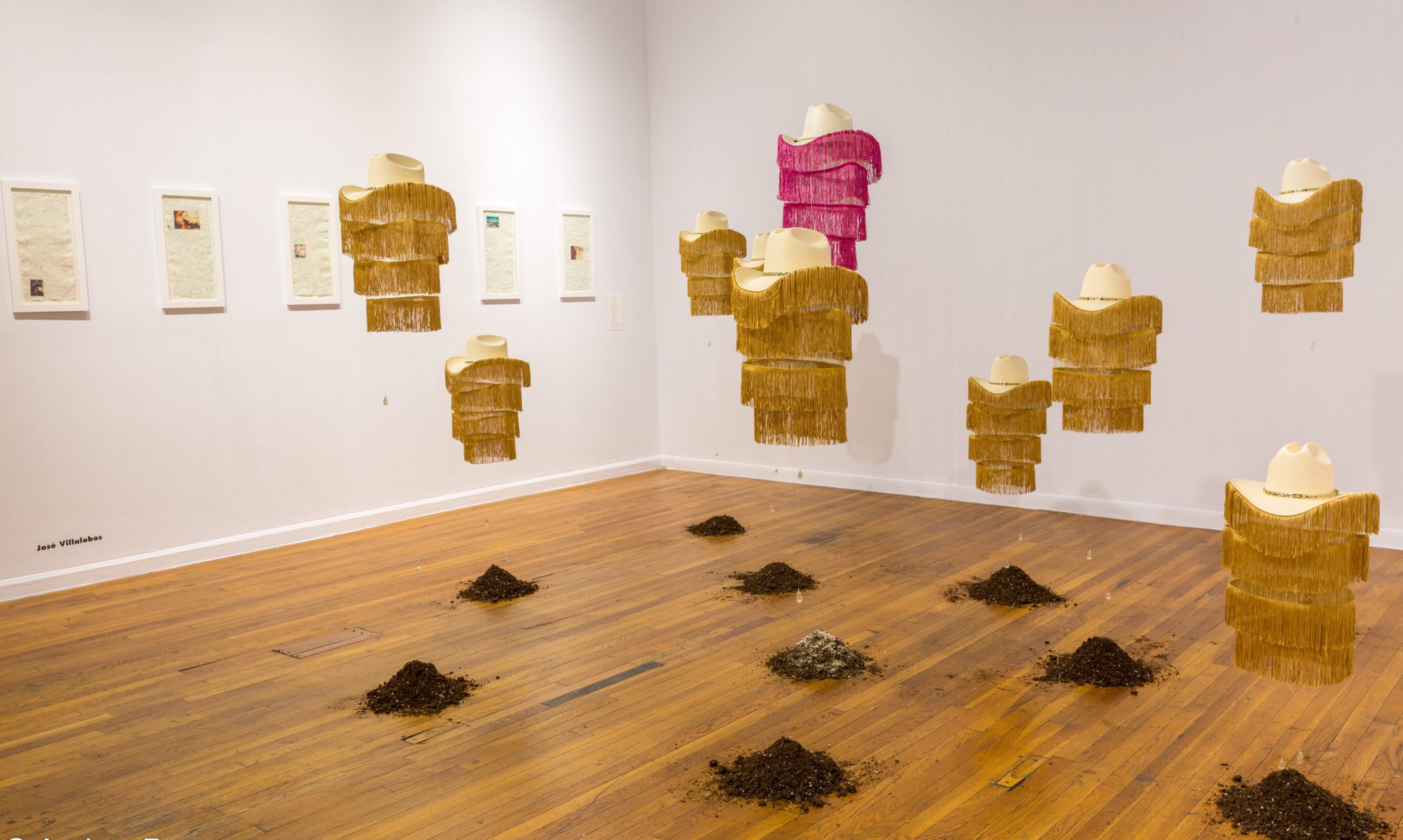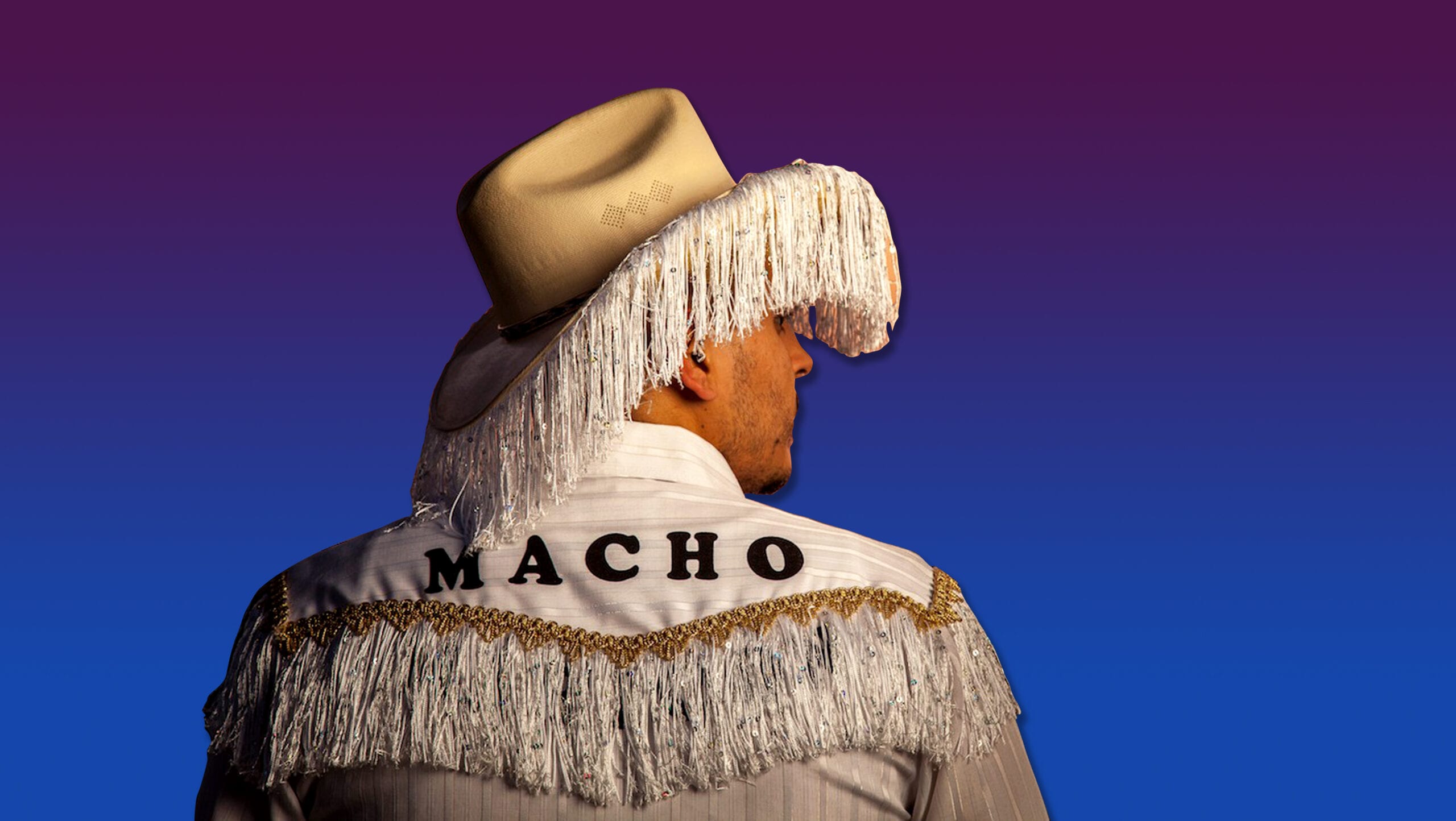On a warm spring day at a ranch outside of San Antonio, Texas, artist Jose Villalobos debuted A Las Escondidas, a performance piece in which he is brutally dragged by a mounted horseman into the center of a dusty corral. Once upright—and after revealing a gold fringe shirt and a flamingo pink buzz cut—Villalobos rolls up his Wrangler jeans, steps into a pair of high heels and begins assembling a tower of 66-pound hay bales. With each addition to the tower, he changes into a new pair of shoes. Eventually, Villalobos trades his sparkly wedges for boots and covers his pink hair with a cowboy hat. In his new, macho uniform, he grasps a can of spray paint and tags the bales—FAG, JOTO, FAG, JOTO—later charging into the tower like a bull at a rodeo clown. With the tower destroyed, Villalobos breaks apart the bales and frantically stuffs his shirt with the slur-covered hay before walking off, silent as a scarecrow.
A video recording of A Las Escondidas (Hide and Seek) played on loop this March as a part of Villalobos’ exhibition, Joto Fronterizo: Selected Works by Jose Villalobos, at Texas A&M International University’s Fine and Performing Arts Center. Joto Fronterizo (Border Faggot) features a survey of more than 25 of Villalobos’ works from the past five years. “I protest the toxicity of machismo through the use of objects that carry a history, specifically within the Norteño culture,” he writes in his artist statement. Alongside videos of his many performances are colourful installations of deconstructed boots, belts, a variety of fringe cowboy hats, fringe sombreros and embroidered shirts typically associated with the northern Mexico/southwestern U.S. border culture. Villalobos’ exhibits and performances highlight the toxic masculinity embedded in these objects, exploring a duality that expresses a tangible queerness both in the objects and the culture.

A Las Escondidas (2019) Credit: Jenelle Esparza, Presa House Gallery
“In almost every single one of my performances, I tend to bring harm to myself in some way,” Villalobos says over the phone from his San Antonio home. In addition to being dragged by a trotting horse, he’s stitched the word “hombre” into the skin of his right hand with a needle and thread, stuffed his mouth with prickly pear cacti, smashed mirrors with a boot and even lifted cinder blocks with a noose tightened around his neck. “I cause harm to myself in my performances to portray the pains and traumas we experience as queer people but can’t see,” Villalobos says. “By performing them, I’m able to physically depict homophobia, hate and the harm of machismo. Since these can be abstract traumas, performing them makes them visible and relatable in a way that some of my installations can’t be. No matter what the viewer’s background is, they have a body and know what it’s like to feel pain, too.”
Villalobos, 31, was born and raised in El Paso, Texas, a U.S.-Mexico border city in the heart of the Chihuahuan Desert, closer to Tucson, Arizona than to Austin, Texas. Villalobos spent much of his childhood visiting relatives across the border—and the Rio Grande—in Ciudad Juárez. It was during these family gatherings with his fronterizo, or border, family that he gained inspiration for much of his work.
“Much of Villalobos’ work incorporates flamboyant accents, like the fringe found on his father’s shirts. By exaggerating them, he flaunts the softness hidden in the harshness of machismo”
“Most of the influence for my work is cultural,” he says, “I would always pay attention to how the men around me were dressed.” For one, he says, there were the hats and sombreros his late father would wear and hang on racks or place on high shelves out of reach from Villalobos and his four siblings—almost as if on display in a gallery themselves. “I especially remember the leather belts,” he says, laughing, “because when it came off, it meant that he was going to whoop our asses.”
Villalobos’ father was a mechanic, as well as a musician and performer. He sang and played guitar, accordion, piano and bass. “He used to be in local Norteño bands that would perform in northern Mexico,” Villalobos says. “I remember he had this big, macho mustache, but at the same time, he would do all of his performances in a shirt with this very flamboyant fringe on it. That look is very common if you pay attention to a lot of Norteño and Banda bands—that’s where I get all of this from in my work. They always perform in these sparkly, sequined or fringed outfits. But, if you had [a man] who was gay wear one of those outfits and perform the same songs, you’d be seen through a completely different lens. You’d be seen as a faggot.” Much of Villalobos’ work incorporates these flamboyant accents, like the fringe found on his father’s shirts. By exaggerating them, he flaunts the softness hidden in the harshness of machismo, while also using the excess of colourful materials to obscure his own identity.
Before graduating with a degree in fine arts, Villalobos began showing in galleries around Texas where he developed many of the installations and performances on display in Joto Fronterizo—including one of his most well known, De La Misma Piel (Of the Same Flesh). In the installation, nine leather belts with homophobic slurs like “delicado” and “mariposa” tooled into them hang on a wall. Displayed on a table before the belts are four large belt buckles resting on purple velvet pillows. Each buckle has a plated gold letter outlined by silver designs. Together, the buckles spell out “Joto.” De La Misma Piel led to Villalobos’ first significant grant from the Guadalupe Cultural Arts Center and laid the foundation for his work as he began exhibiting across the U.S., including shows in New York City and San Francisco in 2019.

FAG (2018) Credit: Michael Cirillos
Another one of Villalobos’ signature works, Sin La “S” (Without the “S”), is a central feature of Joto Fronterizo. Suspended from the ceiling are 10 cowboy hats, each with four separate curtains of fringe that, if worn, would completely obscure the wearer’s face. Nine of the hats have golden fringe, while the tenth is pink. Below each hat is a neat pile of soil. “To grasp Villalobos’ sculptures… [shows] a man that seeks to expose the painful course of his journey as an artist and human being,” curator and art history professor Emmanuel Ortega wrote of the exhibit when it first premiered at Pennsylvania’s Albright College in 2019. “More than anything, his sculptures are an opportunity to exist for one minute in the suspended liminal space from which the pink fringes will eternally float.”
The fringe hats and sombreros used in Villalobos’ installations have also played a role in a number of his performances. In Sequenced, he wears a version of the fringe hat from Sin La “S,” and in FAG, he wears a pair of fringe glasses as he stamps a slur into his forehead. Most notably, he wears a white fringe sombrero in the performance Alamas Fragiles (Fragile Soles), along with an all-white outfit reminiscent of something his father may have worn while performing with his band in Mexico.
Over the past couple of years, many of Villalobos’ fans and online followers have taken notice of—and called out—the use of fringe hats, sombreros and other accoutrements reminiscent of Villalobos’ work by other artists. Recently, they’ve appeared on various performers and celebrities, from country singer Orville Peck—who debuted his fringe, Lone Ranger mask in 2018—to Ellie Goulding’s beaded hat from the 2019 Thanksgiving NFL halftime show, to Billy Porter’s remote-controlled sombrero at this year’s Grammy Awards. These looks, along with Lil Nas X’s fringe suit in the “Old Town Road” music video, are examples of a fashion trend popularized by mostly queer performers borrowing heavily from another culture. For Villalobos, though, they’re about more than fashion: “The imagery I use in my work is far more than just a look,” he wrote in a 2019 Instagram post in response to a quote by Peck in Gay Times Magazine about people of colour and queer people identifying with cowboy culture. “These are components that remain within the Norteño culture and carry a meaning of power and masculinity.”

Sin La “S” (2017) Credit: Andrea Rampone
After the post came to Peck’s attention, the musician reached out to Villalobos, who later posted a new statement, superimposed over a photo of himself wearing one of the fringe hats similar to those in the Sin La “S” installation, on Instagram. “My intent was not to attack any individual, but rather inform and hold accountable of what [Peck is] representing and how he’s chosen to represent it,” Villalobos wrote. “I expressed how my artwork is informed beyond the fringes and growing up in the culture as an oppressed Latinx queer individual… We have a voice for a reason and if we don’t use it we will go unheard.”
In January, Villalobos was selected as the Joan Mitchell Foundation Artist-in-Residence. Though his residency is currently on pause due to the COVID-19 pandemic, Villalobos continues to work from his home studio in San Antonio. His upcoming solo exhibition, En Su Imagen (In his Image)—also temporarily on hold—takes old photos of his father and other men in his family and embosses them with quotes using leather working tools. In another current work-in-progress called Pressured Tongue, Villalobos breaks apart a bit, which is part of a riding bridal used to command, control and steer a horse. The device is put into the animal’s mouth, holds their tongue and pulls on the corner of their mouths when directed by the rider. “It’s about the silencing of queer, POC bodies,” Villalobos says. “And not just the silencing, but the erasure of those bodies. Because when we are silenced, we are erased.”


 Why you can trust Xtra
Why you can trust Xtra


